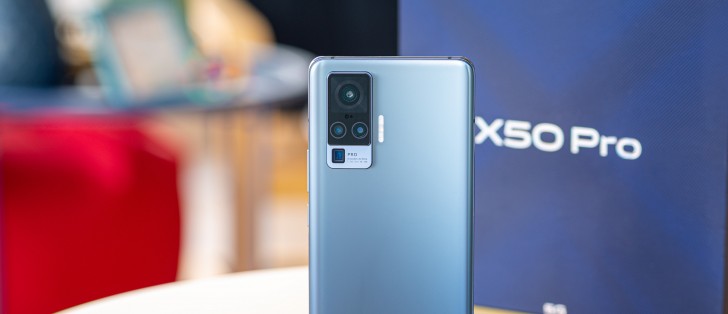vivo X50 Pro review

Low-light image quality
Now, let's look at some low-light images.

Having a great stabilization system is of tremendous help at night. The gimbal allows the main camera of the X50 Pro to use shutter speeds of 1/8s and thus capture more light without resorting to the Night Mode.
Indeed, the main camera captures excellent night shots - they are bright, with abundant detail, good exposure, lively colors and commendable contrast. Even the darkest of scenes turned out outstanding.
Night Mode is available, and it usually takes about 3 seconds. If the phone detects a tripod, it will then use a 10 second Night Mode to capture even more detail. Thanks to the gimbal stabilization and the reviewer's steady hand, the algorithm often mistook it for a tripod. But a handheld 10s shot is a no-go, so if you see the tripod mode activated, shake the phone a bit. How the tables have turned, right?
Anyway, the Night Mode is simply outstanding. It clears the images of noise, balances the exposure, restores the blown highlights and pops detail in the shadows. The photos are a bit brighter and the color saturation is not only better, but more accurate, too.
Those are among the best Night Mode shots we've seen, and they are worth every second of waiting. We recommend using this mode whenever possible.
The X50 Pro also packs a bright triple-LED dual-tone flash. We decided to snap a photo with the flash turned on for a quick comparison. It turned out plenty good with lots of detail and managed to pop the real colors of the snail and the grass, like it is a day. Maybe you should try it in some scenes where you want to pop more color or detail.



Standard mode • Standard with flash • Night Mode
The 8MP snaps from the ultrawide camera are what you'd expect from any such snapper at night - not that good. They are noisy, soft, and quite dark. Surprisingly, the processing manages to save enough detail sometimes and some of the shots are not as bad as we'd expected them to be.
Still, we can hardly recommend using this camera come nighttime.
Night Mode is available on the ultrawide snapper and it takes about 2 seconds to complete. It does a good job in popping more detail in the shadows and also extinguishes most of the noise, so if an ultrawide shot is a must at night, the Night Mode is the way to do it.














Ultrawide camera, Night Mode, 8MP
The camera avoids using the 2x and 5x snappers at night and whether it is a normal or night mode, the main camera and digital zoom will be used instead.
The only time the telephoto cams decided to shoot was at sunset. The 2x images are okay, but nothing spectacular. There is a lot of noise and while the color saturation is good, the photos are often blurry due to the lack of stabilization.



Portrait camera, 2x zoom, 13MP
The 8MP 5x low-light stills are less likely to be blurred because of the OIS, but they are quite dark and very noisy due to the darker aperture. Still, when the camera decides to fire, you can expect detailed enough shots.



Telephoto camera, 5x zoom, 8MP
We also shot our usual posters with the vivo X50 Pro. Here's how it stacks up against the competition. Feel free to browse around and pit it against other phones from our extensive database.



vivo X50 Pro against the OnePlus 8 and the Realme X50 Pro in our Photo compare tool
Selfies
The 32MP selfies out of the vivo X50 Pro are just about okay. Dynamic range is on the narrow side, and we'd appreciate some more sharpness and detail than what we're getting, but colors are on point. The HDR often helps, but sometimes it goes over the top and you won't like what you'd get.
If the light conditions aren't ideal, though the selfie quality goes down the drain in a flash.
Portrait mode on the selfie camera comes with some amount of beatification applied that has no easy one-step solution to remove. That means an extra level of added softness is also present, not just in the background, but also on your subject. On the other hand, the artificial bokeh effect is not turned on by default, you have to specifically enable it.
After all the hassle, the portrait selfies are bad, so we'd stay away from this mode. The separation is not good and all those effects... no, just no.
Video recording
The vivo X50 Pro captures video at up to 2160p at 60fps with its main camera. Gimbal stabilization is always available, there is also electronic stabilization that's always on for all 30fps modes. You can also opt for the so-called Ultra Stable mode that's fixed at 1080p@60fps - it uses 4K@60fps source and crops from its center.
All other snappers can do 1080p@30fps and nothing else. If a 4K resolution is selected, the 2x and 5x modes use the main camera and zoom digitally.
Audio is captured always stereo at 128kbps. You get to pick between the h.264 and h.265 codecs.
The 4K@30fps clips from the main camera are a bit soft, but still with enough detail, excellent colors and contrast. They are steadier than the 60fps because of EIS but have a bit narrower field of view.
The lack of EIS is the reason why the 4K@60fps footage is sharper and with wider FoV - it wasn't cropped and upscaled back to 4K. The 60fps clips are obviously sharper and overall - flagship-grade. Everything is great - the colors, the foliage, the buildings. They are noise free, too.
Both 30fps and 60fps videos in 1080p resolution exhibit the exact same properties, with a twist - there is no crop, and the footage is sharp and rich in detail in both occasions.
The 1080p@30fps video from the ultrawide camera is excellent - rich in detail, with high contrast and lively colors. We have no complaints whatsoever.
The 1080p@30fps clips from the zoom cameras are also of superb quality. They are sharp, with high dynamic range, good contrast and satisfying colors, even if a bit washed out.
Now, let's test that gimbal properly. First, we walked with the phone and the stabilization is outstanding.
Then we decided to run and yet the footage came out impressive in spite of our poor running efforts.
And here is the same run but shot with the Ultra Stable mode. Cool, right?
We decided to pit vivo X50 Pro next to one of the best flagships as far as video stabilization is concerned - the iPhone 11 Pro Max. The first side-by-side video shows 4K@30fps footage from both phones taken while walking and then running. It seems both devices are on par.
The second side-by-side video shows footage in 1080p@30fps. Here the X50 Pro uses a more aggressive electronic stabilization and when we started running - the X50 Pro did a lot better.
Then we used the Ultra Stable Mode of the X50 Pro against 1080p video from the iPhone. Apple did better here.
What we can take from these? Well, if you are running - there is no better smartphone to stabilize your action video than the vivo X50 Pro. But for any other occasion - there is another smartphone with better stabilization that will beat it.
Finally, closing this camera section off, here is the vivo X50 Pro in our video comparison database.



vivo X50 Pro against the OnePlus 8 and the Realme X50 Pro in our Video compare tool
Reader comments
- Bilawal
- 07 Aug 2023
- CJX
Please don't buy, many of my friends purchased this phone, and after almost one year green vertical lines appear on screen. Very pathetic.
- YUKI93
- 28 Sep 2021
- TC{
You can use any image resizer app on Android. On Windows, you can simply use MS Paint as I did. You can even use Photoshop or Photopea, which is a browser-based open-source alternative to Photoshop if you want more freedom.













































